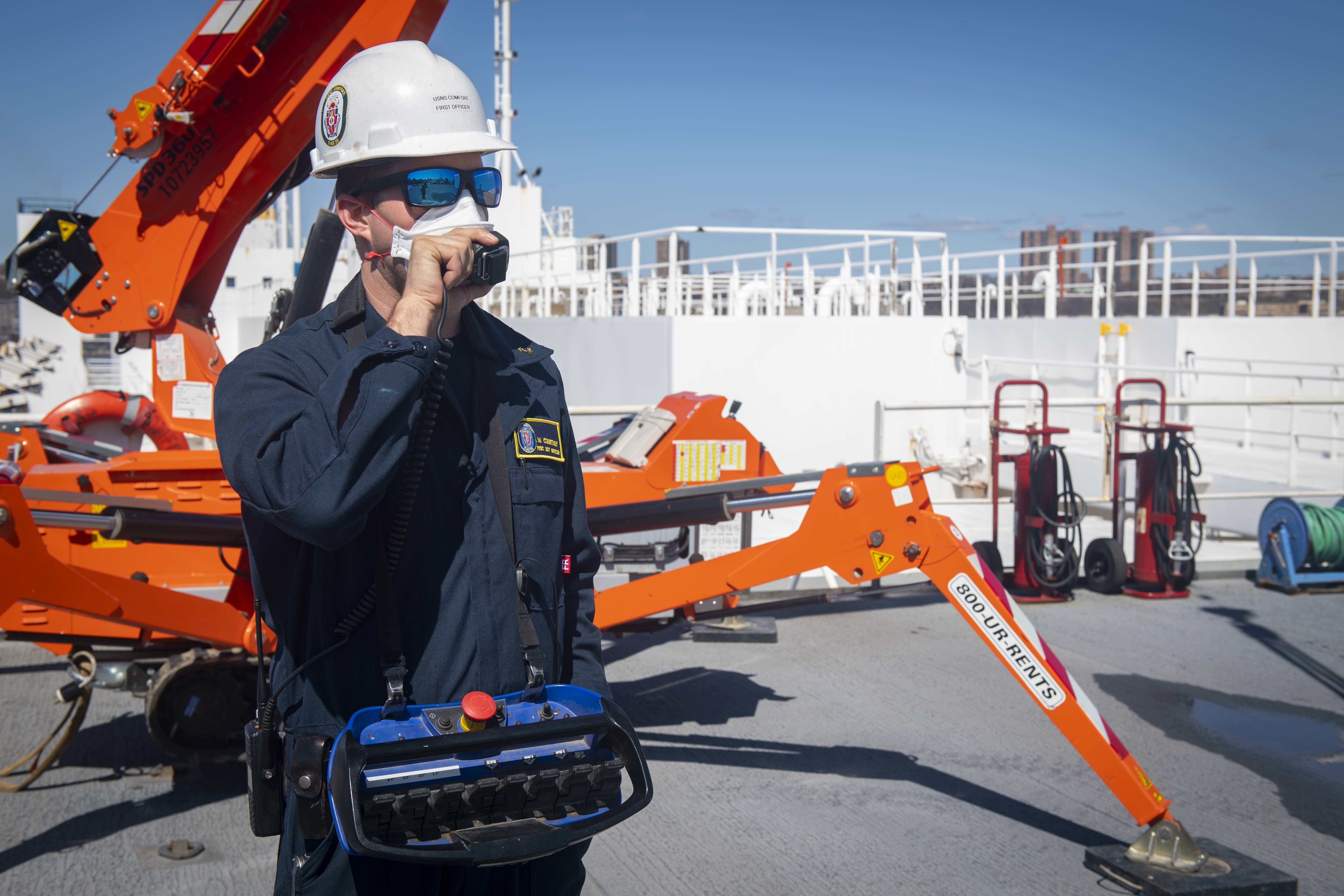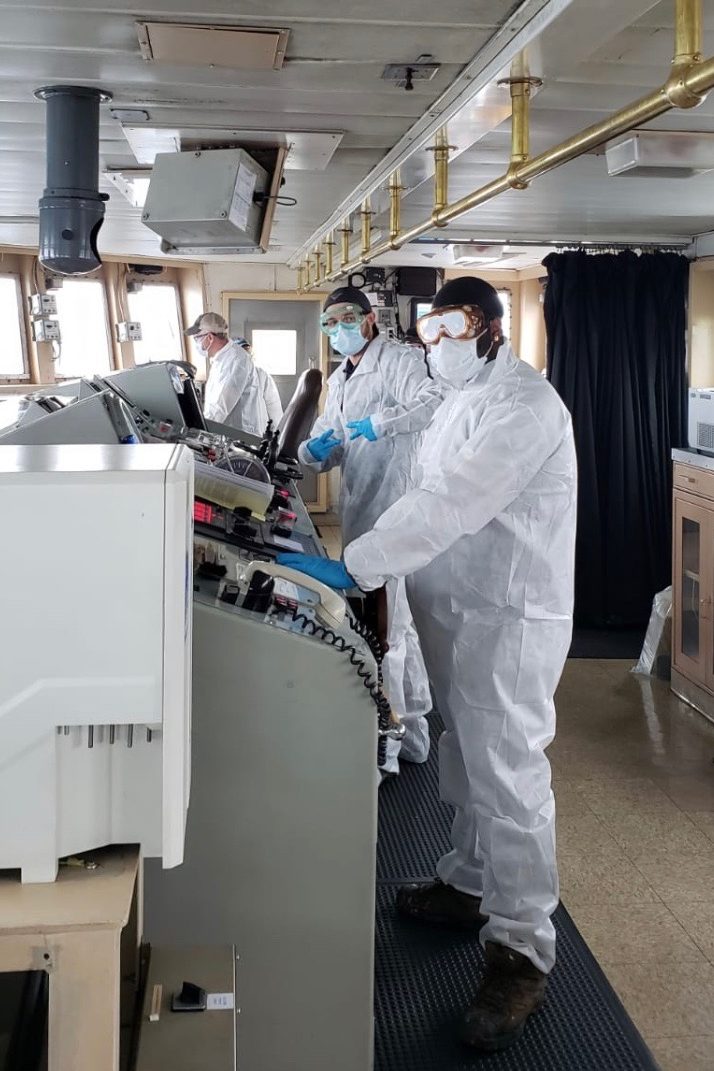
This post has been corrected to state there have been cases of COVID-19 among civilian mariners on Military Sealift Command ships. Two cases emerged on oiler USNS Leroy Grumman (T-AO-195) between the Friday interview and Wednesday article publication. That ship is in Boston Ship Repair for maintenance. Two CIVMARS were infected on hospital ship USNS Comfort (T-AH-20) early in its New York mission and have since recovered, but that was not disclosed by MSC during the interview. A fifth CIVMAR is known to have contracted the disease while on leave and has also recovered.
The Military Sealift Command is keeping supplies moving uninterrupted throughout the globally operating Navy fleet and has done so with zero COVID-19 infections among its civilian mariners at sea due to early and aggressive actions, the commander of MSC told USNI News.
Through “bubble-to-bubble” transfer of personnel to ensure everyone stepping foot on a ship is virus-free, to using cleaners and UV light to disinfect goods before bringing them to warships, Rear Adm. Michael Wettlaufer said the organization is doing everything it can to keep its own Combat Logistics Force (CLF) ships safe and effective and to ensure they aren’t a vector of transmission of the disease to deployed warships.
Whether it’s fresh foods, spare parts or even toilet paper, “that stuff comes aboard and is either cleaned right away for onward movement in the ship for storage, or it’s left in a position where it can get lots of sunlight and outside air. We know that time, of course, as well as sunlight, UV light, and then cleaning will really drive the possibility of the virus surviving down very very low,” Wettlaufer said.
“And we also limit the number of people that are involved in that touching of the cargo when it gets on the deck. So where possible, we just have people with [personal protective equipment] on, and as limited a number of people that will go and clean the stores as they come aboard, and then those stores get moved on further in the ship via forklifts and elevators and conveyors inside the ship. And then they go into storage areas inside the ship, where further time has its great effect on whatever the potential COVID, coronavirus, would be on these things. So we’ve got these layers. And on the other end, coming off the ship, we don’t really touch the other ships, there aren’t any people going from the CLF ship to the receiving ship. But of course they are touching the things that are going over, so we continue to use PPE, gloves … during the transfer from ship to ship to minimize that contact.”
When the MSC ships pull into port to pick up new supplies or fuel, few or no civilian mariners ever leave the ship. Port workers on the pier can load up goods onto conveyor belts to the ship or handle refueling lines, meaning the MSC crew can stay safely aboard the ship while retrieving the “beans, bullets and gas” they’ll deliver to the fleet.
Wettlaufer said MSC is already working with engineers at Naval Sea Systems Command to look at wrapping materials that could be used to keep pallets or other items clean as they move through the logistics chain to a pier and ultimately onto MSC ships and then warships. The admiral said that if something could be wrapped while it was still known to be clean, then with handlers still using gloves and other PPE along the way and finally the wrapping thrown away as waste material, the likelihood of transmission to a warship would be almost zero. That effort is being worked with MSC and NAVSEA today.
Next in line is a UV light system that could go on conveyor belts and clean items as they come onto the CLF ships at the pier.
“One of the things that would be really great for us is, stuff comes up the conveyor belt and it gets radiated, which then further drives down the potential – and we continue to use the handling protocols we have in place – to even further decrease the potential” of transmission of the virus.
Other longer-term ideas being kicked around are a UV robot of sorts that would clean storerooms after they’ve been emptied and before they’ve been replenished with new goods from a new port, and handheld UV wands.
“One of the things we have to worry about too is, is there any challenge to the human involved? So a lot of work going on in this area with NAVSEA, as well as with the chemicals that you may use on things. We don’t want to use chemicals on the ship that could damage equipment in any way, so we’re really diligent about the kinds of things we use to clean. We don’t want to use things to clean around any kind of fresh food and vegetables that could get on the fresh food and vegetables, so that’s one of the other important things about the wrapping systems that we put around those, the plastics,” Wettlaufer said, noting that MSC began its precautions very early and intended to continue to hone its approach indefinitely, to ensure it was using all the best approaches to keeping its ships and the Navy ships they supply clean.

The admiral said there hadn’t been any orders from higher up, but rather that MSC took it upon itself early this year to begin crafting a pandemic response. MSC is now in its fourth iteration of its procedures, Wettlaufer said, and “we are well down the path of honing or really putting a fine point on a lot of the things we’ve done. So the guidance we’re following is really the things we’re learning about the virus, and we went as aggressively as we possibly could go very early to drive down the risk, and we’re finding out now that the things we were doing are certainly being proven by science, if you will, or proven by experimentation, and more importantly we are doing very well in that we haven’t had any kind of a transmission in this process that we know about. The evidence is we have been doing all the right things.”
Much like other deploying ships, new sailors moving to and from boot camp and mission-essential personnel on travel, MSC is using “bubble to bubble” transfers for its civilian mariners: they first go into a 14-day quarantine in a hotel room to make sure they don’t show any symptoms; they then move into potentially another isolation period on a clean ship in port to await their movement, and then they either go to their deploying ship or are put onto another military ship or aircraft to be transported to another operating theater to get to their assigned ship. All the while, they are not interacting with anyone outside the clean bubble, thereby drastically reducing the likelihood that anyone with the virus is ending up on a deployed ship.
Of course no methods are perfect – even with restrictions in place, destroyer USS Kidd (DDG-100) found itself with a COVID-19 outbreak that began about 30 days after its last port call, with the Navy saying it may never know how the virus got onboard the ship.
Still, Wettlaufer said MSC’s actions collectively “prevent the possibility (of an outbreak) to the nth degree.”
The admiral assured that, despite broken supply chains at home, with grocery stores struggling to keep certain household goods and foods in stock, that the supply chain for Navy ships was not seeing those disruptions.
“The things that are ordered, we’re able to deliver those things. So if a ship orders spaghetti, we’re getting spaghetti,” he said. And importantly for morale, “those care packages are still getting there. There’s no disruption in that. It may take a little longer at times than somebody might expect if they were living in the States, but the care packages are getting there and we’re certainly doing that really important part of the morale business, which is getting a letter from home, or getting Girl Scout cookies or whatever the things are that people want to send.”
Other operations are more challenging due to social distancing requirements, such as ship maintenance and employee training.
Wettlaufer said the MSC ships are repaired at commercial yards across the country, and getting original equipment manufacturers’ technical representatives to repair yards or pier side has been challenges while also maintaining social distancing.
“There is a cost there in potential delays in getting technical support,” he said, but MSC is working with its partners to find distance solutions, such as having technical support personnel provide support via telephone or video from a nearby hotel instead of coming onto the ship itself.
On new employee training, Wettlaufer said Military Sealift Command is hiring and training new personnel as quickly as it can while also allowing for social distancing. Class sizes are smaller to keep people more spread apart, but he said MSC is trying to get creative with the sequencing of training to get new employees through the pipeline as fast as possible.
“If somebody’s looking for a job opportunity out there, sealiftcommand.com, that’s a good place to look,” Wettlaufer said.
“MSC is open for business.”





